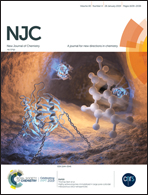Nitrogen-doped carbon dots derived from electrospun carbon nanofibers for Cu(ii) ion sensing†
Abstract
Nitrogen-doped carbon dots were facilely synthesized via the chemical breakdown of electrospun polyacrylonitrile-based carbon nanofibers. The results of transmission electron microscopy, X-ray photoelectron spectroscopy, Fourier transform infrared spectroscopy, and Raman spectroscopy demonstrated that the prepared N-doped carbon dots with a relatively narrow size distribution exhibited abundant C, N, and O containing functional groups. In the meantime, aqueous N-doped carbon dots exhibited excitation-dependent photoluminescence. Moreover, due to the quenching effect induced by the strong coordination interaction between the Cu2+ ions and the surface functional groups of the obtained N-doped carbon dots, an efficient fluorescent sensing platform was developed to detect Cu2+ ions, showing high sensitivity and selectivity to Cu2+ ions with a detection limit of 5 nM in the linear range of 0–10 μM. This work has provided a simple and effective approach for fabricating N-doped carbon dots as a promising fluorescent material for heavy metal sensing.



 Please wait while we load your content...
Please wait while we load your content...